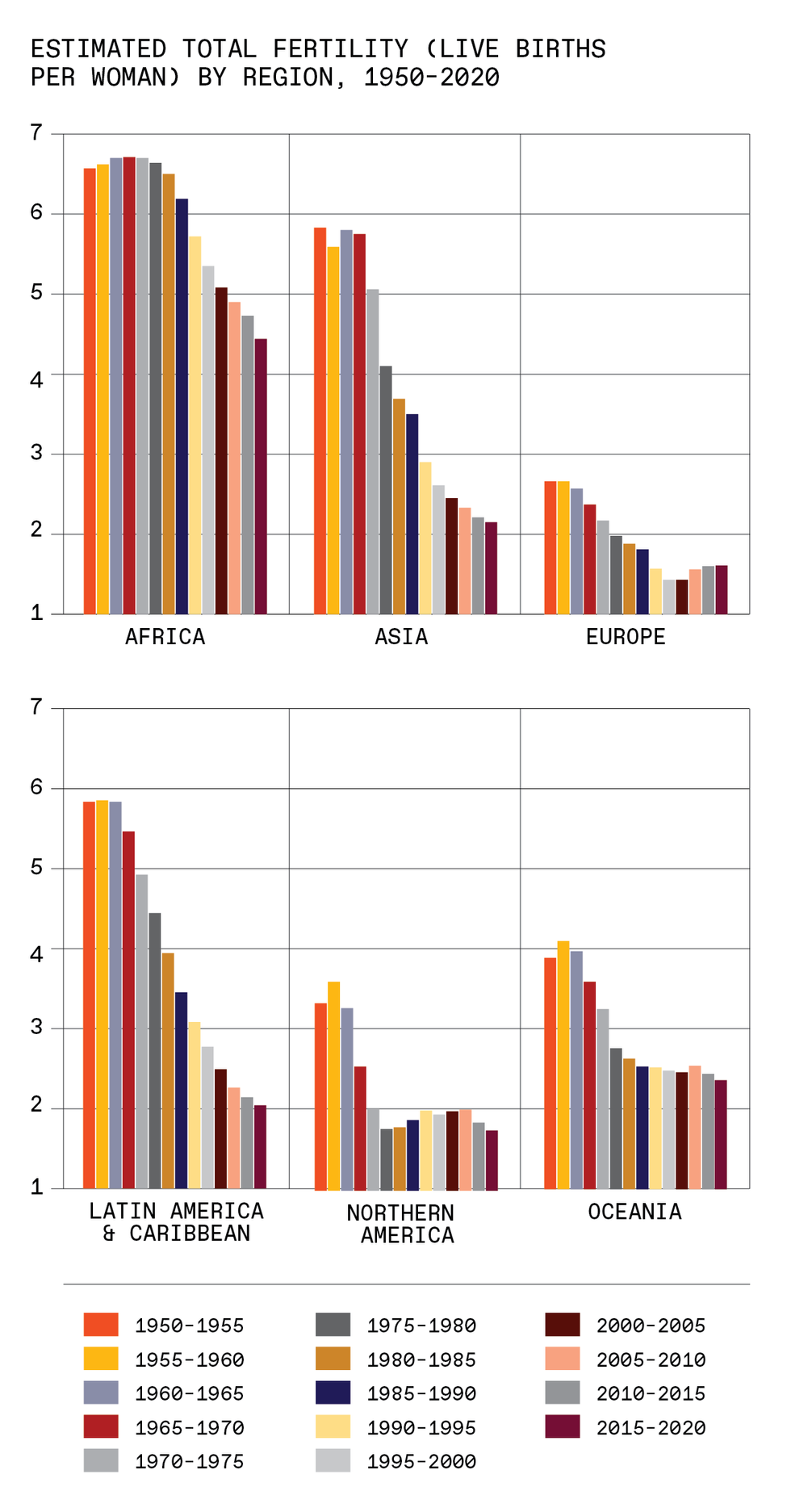In 1960, Science published a paper byHeinz von Foerster predicting that on Friday, 13 November 2026, the "human population will approach infinity if it grows as it has grown in the last two millennia." Just a few years after this preposterous doomsday alarm, the annual growth of global populationpeaked at about 2.1 percent and immediately began to decline. By 2020 the growth rate stood at just a bit more than 1 percent, the result of the steadily declining total fertility rate (TFR), the number of children born to a woman during her reproductive period.
In preindustrial societies this rate stood commonly at 5 or higher; during the United States' baby-boom years (1945–1964) its rate peaked at about 3.2. The replacement rate in developed countries is roughly 2.1 children per woman. Some affluent nations have had below-replacement TFRs for several decades (Germany since 1970, Italy since 1976), but this fertility retreat has now deepened to such an extent that substantial population declines by 2050 are now inescapable in at least a quarter of the world's nations.
As long as the total fertility rate remains just below the replacement rate, its rebound is quite likely. But when the TFR falls very far it means that an increasing share of families are having just one child or none at all, and that makes it much harder to lift fertility through pronatalist policies, such as paying people to have additional children. TFRs below 1.5 lead to demographically uncharted territory. This group of countries now includes many states in Central and Eastern Europe and also such populous countries as Japan, Germany, Italy and South Korea.
Near-term demographic forecasts are far from perfect, but there is no danger of making very large errors, say, of 50 percent. That's because so many future mothers are already with us, and because TFRs do not quickly double. The latest U.N. population projections for 2050 ( released in 2019) show continued global growth, mainly because African TFRs are still mostly above 3. But the medium-growth forecast sees slight declines both in Europe (–5 percent) and in China (–2.5 percent), while the low-growth forecast sees declines of 26 percent in Ukraine, 16 percent in Italy, 15 percent in Russia, 13 percent in Spain, and nearly 9 percent in China.
Shrinking population together with a higher average age erodes the tax base, raises infrastructure costs, and leads to social isolation, as settlements dwindle and die.
The decline has been underway for some time in villages and small towns, where the sequence is much the same everywhere: First they lose their school, then the post office, gas station, and grocery store. Finally, a settlement is administratively amalgamated with its similarly fated neighbors. You can see what is left behind without leaving your room by taking Google Street View tours of desolate mountain villages in Tohoku, the northern (and the poorest) part of Japan's largest island, where almost every third person is now over 65 years old. Or look at the forlorn places not far from Bucharest, Romania's capital, where all but a few young people have left for Western Europe and the TFR is below 1.4.
This process can be found even in certain parts of countries that are still growing, thanks to immigration. The United States is losing people across much of the Great Plains, Germany throughout most of the former German Democratic Republic, Spain in Castile and Léon and in Galicia. Shrinking population together with a higher average age erodes the tax base, raises infrastructure costs, and leads to social isolation, as settlements dwindle and die. It is all very depressing to contemplate.
Of course, in a truly long-range perspective this is hardly surprising. Ten thousand years ago there were perhaps just 5 million people on Earth—too few, it would have seemed, to become the dominant species. Now we are closing in on 8 billion, and the total may peak at more than 10 billion. We may start losing that global primacy sooner than we think, leaving more room for bacteria, birds, and bears.

This article appears in the October 2021 print issue as "What Goes Up..."
Vaclav Smil writes Numbers Don’t Lie, IEEE Spectrum's column devoted to the quantitative analysis of the material world. Smil does interdisciplinary research focused primarily on energy, technical innovation, environmental and population change, food and nutrition, and on historical aspects of these developments. He has published 40 books and nearly 500 papers on these topics. He is a distinguished professor emeritus at the University of Manitoba and a Fellow of the Royal Society of Canada (Science Academy). In 2010 he was named by Foreign Policy as one of the top 100 global thinkers, in 2013 he was appointed as a Member of the Order of Canada, and in 2015 he received an OPEC Award for research on energy. He has also worked as a consultant for many U.S., EU and international institutions, has been an invited speaker in more than 400 conferences and workshops and has lectured at many universities in North America, Europe, and Asia (particularly in Japan).



